Self-Help in Field Conditions
Content
- Importance of Self-Help
- Types of Injuries in Field Conditions
- First aid for bleeding
- Airway clearance and resumption of breathing
- Providing assistance for penetrating chest injury
- Types of Diseases in Field Conditions
- Cold-related Diseases
- Gastrointestinal Diseases
- Sensations of Dehydration
- What Should Be in the Individual First Aid Kit
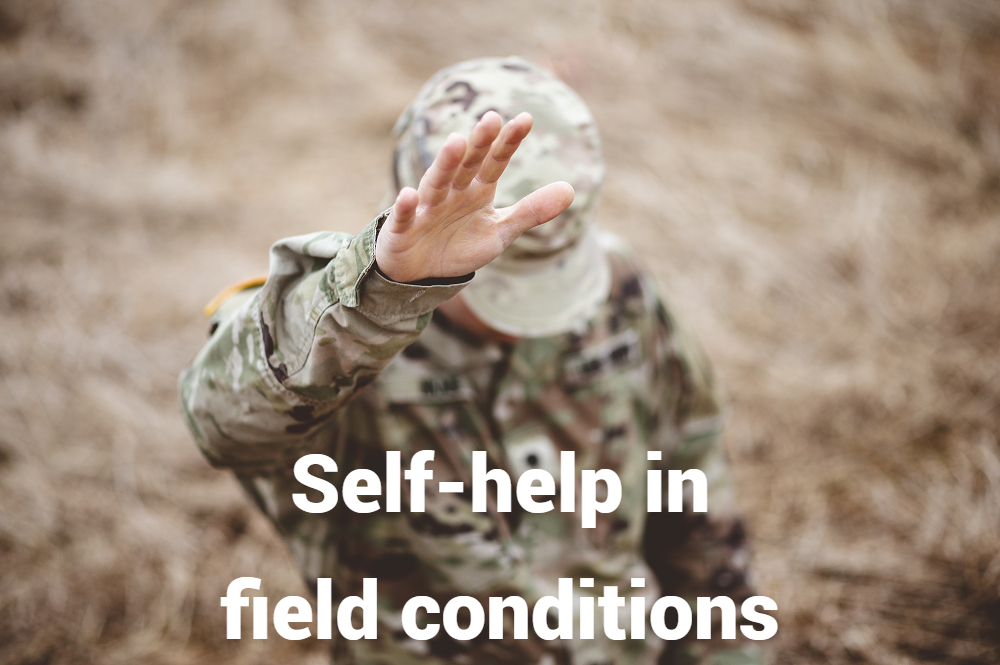
Self-help in field conditions is a critically important skill for those in military conflicts, expeditions, or even just traveling to remote areas. In such situations, the ability to provide self-assistance can determine the outcome and impact overall safety and survival.
One of the key aspects of self-help in field conditions is the mastery of first aid skills. Knowing how to provide effective assistance in case of injuries, burns, or other medical incidents can save lives.
Understanding the use of improvised materials to create medical remedies and supplies is also an important element. The ability to organize one's own living and survival in challenging conditions plays a crucial role in field self-help. Knowledge of how to choose a safe place for shelter, how to collect water correctly, and how to prepare food with minimal resources allows for effective management of limited resources and ensures stability in difficult conditions.
Psychological resilience and the ability to manage stress are also components of self-help in field conditions. The ability to focus on what matters, not to lose morale in critical situations, and to adapt quickly to changes are key elements of survival in such circumstances.
In summary, self-help in field conditions is an essential part of the equipment and skills of anyone who may find themselves in remote or extreme situations. These skills enable the preservation of life and ensure safety in situations where every decisive action can be crucial.
Importance of Self-Help
Self-help is a crucial element in military preparation that significantly enhances the effectiveness and endurance of personnel in performing tasks. This aspect plays a key role in ensuring safety and successful mission completion in various conflicts and crisis situations.
The importance of self-help is evident in the military's ability to react effectively to stressful situations and quickly adapt to changes in war and field conditions. Training in personal self-defense skills, first aid, and survival allows military personnel to reliably protect themselves and their comrades in any circumstances.
Training places importance on aspects such as physical and psychological preparedness. Specialized methods help maintain optimal physical and mental conditions for military personnel. Sports training, stress resistance, and the development of determination are key elements that prepare military personnel to overcome any difficulties.
An emergency often requires a quick response and self-help skills. Military personnel must be prepared to provide assistance to themselves and their comrades even in hard-to-reach and hostile conditions. First aid skills, mastery of survival techniques, and the ability to assess danger are integral parts of military training. In addition, self-help contributes to the formation of internal discipline and responsibility.
A military service member who can effectively manage their time, resources, and stressful situations becomes a reliable link in the overall chain of defense and security.
Therefore, the importance of self-help in military preparation cannot be overstated. It not only increases their resilience but also makes them more effective and reliable in carrying out tasks in the modern world.
Types of Injuries in Field Conditions
In field conditions, various types of injuries can occur as a result of gunshot, cold, explosive, thermal, chemical, biological, or radiation exposure. The most common injuries in field conditions include:
- Bleeding - loss of blood due to damage to blood vessels. Bleeding can be external or internal, arterial or venous, massive or minor. Bleeding leads to reduced blood clotting, oxygen deprivation to tissues, shock, or death.
- Airway obstruction: In this condition, air cannot pass freely from the nose or mouth to the lungs. Airway obstruction can be caused by a foreign body, blood, mucus, vomit, tumors, head or neck injuries, allergic reactions, poisoning, or other causes. Airway obstruction leads to cessation of breathing and then cardiac arrest.
- Penetrating chest injury - an injury in which the integrity of the chest wall and lungs is compromised. Penetrating chest injuries can result from gunshot, cold, explosive, or other trauma.
- Firearm injuries: This includes various types of firearm injuries, such as gunshot wounds, shrapnel injuries, and blast injuries. Such injuries can be severe and require prompt medical assistance.
- Cuts and open wounds: Occur due to contact with sharp objects or materials. It is important to promptly clean and protect them from infections.
- Fractures and sprains: Caused by trauma or accidents. Require stabilization and may be accompanied by pain and limited mobility.
- Poisoning and infections: Arise from improper food or water consumption, contact with poisonous plants or animals. Administering antibiotics and providing first aid are critical.
- Hypothermia and overheating: Disruption of thermoregulation can lead to hypothermia or overheating. Urgent assistance in restoring thermal balance is mandatory.
- Explosion injuries: Include injuries from shock waves and shrapnel. Require comprehensive treatment and immediate medical assistance.
- Burns - damage to the skin or mucous membranes due to exposure to high temperature, electricity, chemicals, radiation, or friction. Burns can be of varying severity, from redness to tissue necrosis. Burns lead to pain, swelling, blisters, ulcers, scarring, infection, dehydration, shock, or death.
First aid for bleeding
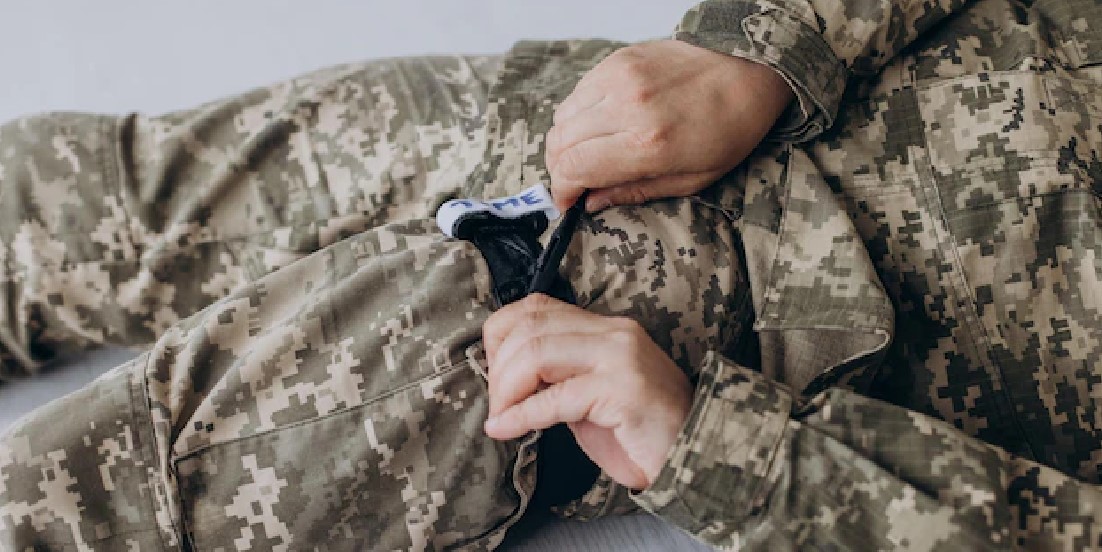
Bleeding is the loss of blood due to vessel damage. Bleeding can be external or internal, arterial or venous, massive or minor. First aid for bleeding involves stopping the bleeding and preventing shock. To stop bleeding, you need to:
- Apply a sterile bandage to the wound if the bleeding is minor or venous;
- Apply a tourniquet or improvised tourniquet (belt, rope, scarf) to the vessel above the wound if the bleeding is arterial or massive;
- Elevate the injured limb above the level of the heart if possible;
- Provide warmth and calm to the injured person, prevent heat and moisture loss;
- Monitor the breathing, pulse, blood pressure, and consciousness of the injured person;
- Remove the tourniquet no later than 2 hours after application if the bleeding has stopped or reposition it to another location if the bleeding continues.
Airway clearance and resumption of breathing
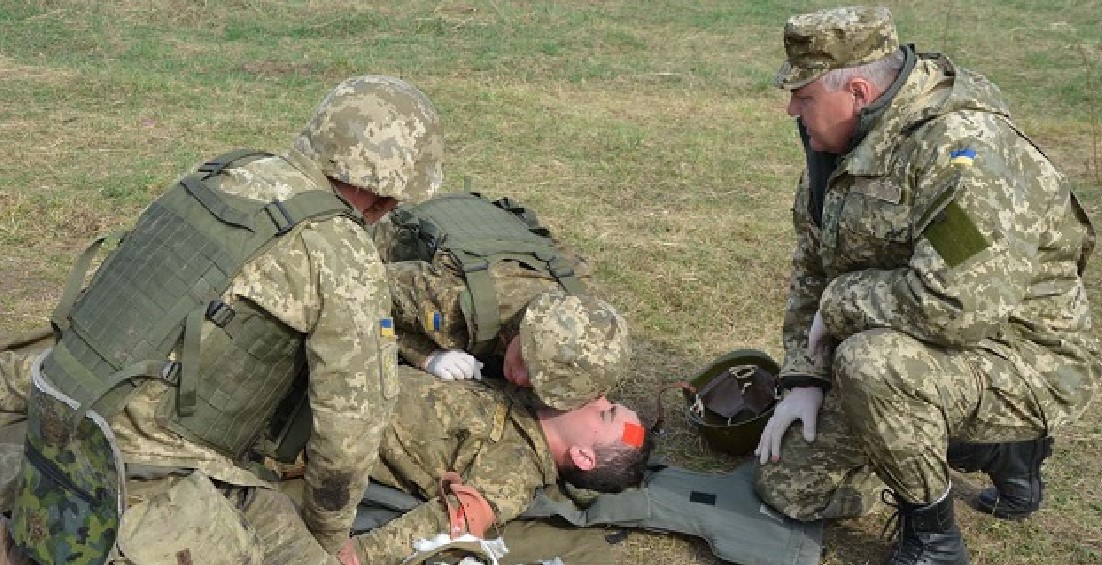
Airway obstruction is a condition where air cannot pass freely from the nose or mouth to the lungs. Airway obstruction can be caused by a foreign body, blood, mucus, vomit, tumors, head or neck injuries, allergic reactions, poisoning, or other reasons.
Airway obstruction leads to cessation of breathing and then to cardiac arrest. First aid for airway obstruction involves clearing the airways and restoring breathing. To clear the airways, you need to:
- Clean the oral cavity from foreign bodies, blood, mucus, or vomit using fingers, tweezers, or improvised tools;
- Tilt the head backward or lift the chin to open the airways;
- Perform artificial respiration mouth-to-mouth or mouth-to-nose if breathing is absent or inadequate;
- Perform indirect heart massage if the pulse is absent or weak;
- Continue artificial respiration and indirect heart massage until breathing and pulse are restored or until medical help arrives.
Providing assistance for penetrating chest injury
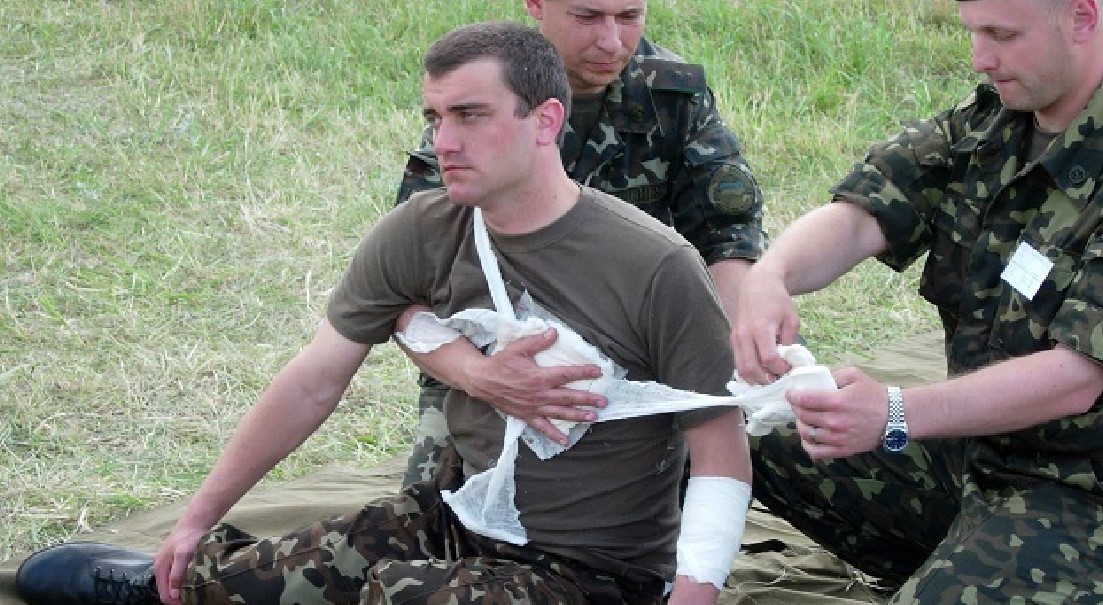
Penetrating chest injury is an injury where the integrity of the chest wall and lungs is compromised. Penetrating chest injury can result from gunshot, cold, explosive, or other trauma.
Penetrating chest injury leads to respiratory, circulatory, and gas exchange disturbances, as well as the development of complications such as pneumothorax, hemothorax, hydrotorax, hemopneumothorax, shock, or death. First aid for penetrating chest injury involves:
- Ensuring the free breathing of the injured person by removing obstructive clothing, weapons, or equipment;
- Applying an airtight dressing to the wound to prevent air from entering the pleural cavity and the development of pneumothorax;
- Applying a vented dressing to the wound if there are signs of tension pneumothorax, cyanosis, tachycardia, hypotension, displacement of the heart to the opposite side;
- Raising the injured person to a semi-sitting or lying on the side with the injured side up to facilitate breathing and prevent blood aspiration;
- Providing warmth, calm, and support to the injured person, preventing heat and moisture loss;
- Monitoring the breathing, pulse, blood pressure, and consciousness of the injured person;
- Transporting the injured person to the nearest medical point or hospital, if possible, considering their condition and circumstances.
Types of Diseases in Field Conditions
In field conditions, one can encounter various types of diseases that can be caused by infections, poisonings, allergies, hypothermia, overheating, sunburns, bites from animals or insects, as well as stress, fatigue, insufficient nutrition, or water supply. The most common diseases in field conditions include:
Cold-related Diseases
Cold-related diseases are a group of infectious diseases that affect the respiratory tract. These diseases can be caused by viruses or bacteria, as well as a weakened immune system, hypothermia, overheating, air pollution, or contact with sick people.
Cold-related diseases are accompanied by symptoms such as cough, runny nose, headache, sore throat, fever, weakness, muscle or joint pain. First aid for cold-related diseases involves:
- Ensuring sufficient rest and sleep;
- Drinking an adequate amount of fluids, especially warm beverages that reduce dryness and irritation of the respiratory tract;
- Taking medications for headache, fever, cough, or sore throat if available;
- Reducing contact with other people to avoid infecting them;
- Seeking medical attention if symptoms do not improve within 3-5 days or if signs of complications such as pneumonia, sinusitis, otitis, bronchitis, or angina appear.
Gastrointestinal Diseases
Gastrointestinal diseases are a group of diseases that affect the stomach, intestines, or liver. Gastrointestinal diseases can be caused by infections, poisonings, allergies, stress, improper nutrition, contaminated water or food, as well as bites from animals or insects.
Gastrointestinal diseases are accompanied by symptoms such as vomiting, diarrhea, abdominal pain, dizziness, weakness, loss of appetite, dehydration, excitement, or depression. First aid for gastrointestinal diseases involves:
- Temporarily stopping food intake to avoid irritating the stomach and intestines;
- Drinking an adequate amount of fluids, especially rehydration solutions that restore the body's water and electrolyte balance;
- Taking medications for abdominal pain, dizziness, weakness, or dehydration if available;
- Gradually introducing light foods into the diet, such as rice, bananas, crackers, apples, eggs, chicken broth, or yogurt;
- Seeking medical attention if symptoms do not improve within 2-3 days or if signs of complications such as blood in stools, high fever, seizures, severe abdominal pain, or jaundice appear.
Sensations of Dehydration
Sensations of dehydration are a condition where the body loses more water than it receives. Sensations of dehydration can be caused by excessive sweating, vomiting, diarrhea, inadequate fluid intake, high air temperature, sunstroke, intense physical exertion, or other causes.
Sensations of dehydration are accompanied by symptoms such as thirst, dryness in the mouth, mucous membranes and skin, reduced urine output, dark urine color, headache, weakness, dizziness, seizures, excitement, or depression. First aid for sensations of dehydration involves:
- Drink an adequate amount of fluids, especially rehydration solutions, to restore the body's water and electrolyte balance;
- Avoid alcohol, caffeine, sweet, or carbonated drinks that can increase water loss or irritate the stomach;
- Increase the consumption of fresh fruits, vegetables, juices, and soups containing water and vitamins;
- Reduce physical activity, wear light and loose clothing, protect yourself from direct sunlight, stay in a cool and ventilated place;
- Seek medical attention if symptoms do not improve within a few hours or signs of severe dehydration, such as dry and cold skin, sunken eyes, severe weakness, confusion, loss of consciousness, or shock, appear.
What Should Be in the Individual First Aid Kit
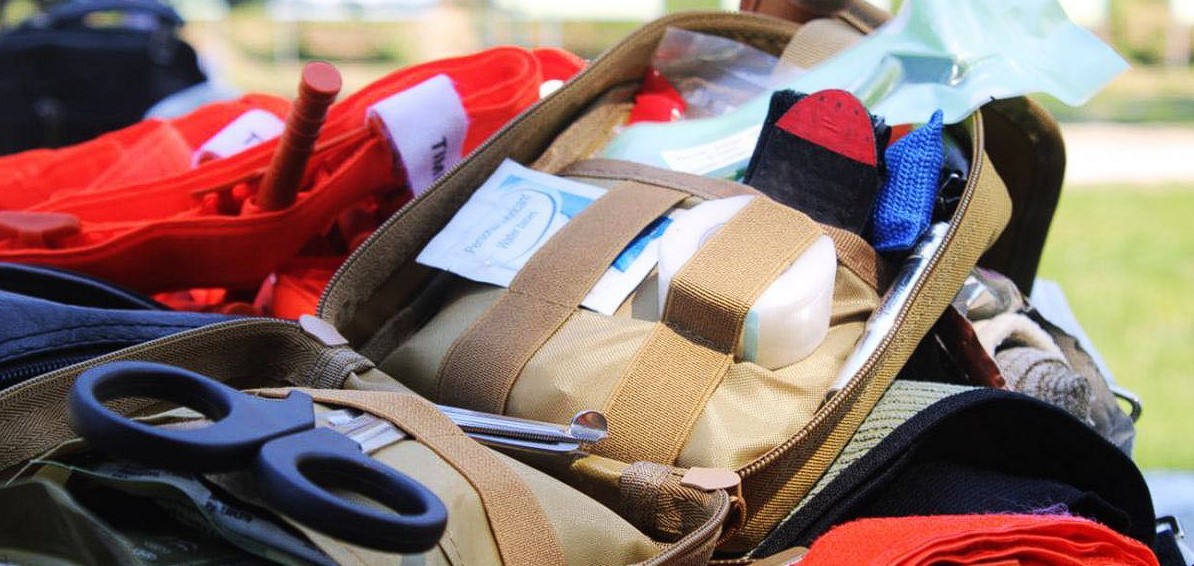
An individual first aid kit is a set of necessary tools and equipment for self-help and mutual assistance in field conditions. The individual first aid kit should be compact, lightweight, convenient, protected from moisture, dirt, and damage. The individual first aid kit should contain the following elements:
- Sterile bandages, plasters, wipes, cotton, bandages, adhesive plaster, antiseptics, antibiotics, analgesics, anti-inflammatory, antiallergic, antiemetic, rehydration, anthelmintic, antimalarial, and other medicines that may be needed depending on the situation and region.
- Tourniquet, scissors, tweezers, needles, thread, syringes, needles, thermometer, magnifying glass, matches, candles, flashlight, mirror, whistle, compass, map, watch, signal flare, foil, bags, film, passport, document copies, money, phone, charger, batteries, radio, camera, notepad, pen, pencil, and other items that may be needed for communication, orientation, identification, documentation, entertainment, or other purposes.
- Water, food, clothing, shoes, jacket, hat, gloves, scarf, tent, sleeping bag, mat, mosquito net, repellent, sunscreen, sunglasses, soap, toothbrush, toothpaste, comb, towel, toilet paper, sanitary pads, condoms, and other personal hygiene items, protection against bad weather, insects, diseases, or other hazards.
This is an example of what should be in the individual first aid kit. You can modify or supplement it depending on your needs, capabilities, and conditions. The main thing is not to forget about it and always have it with you. The individual first aid kit is your reliable assistant in case of emergencies. Be prepared for them and take care of your health!
